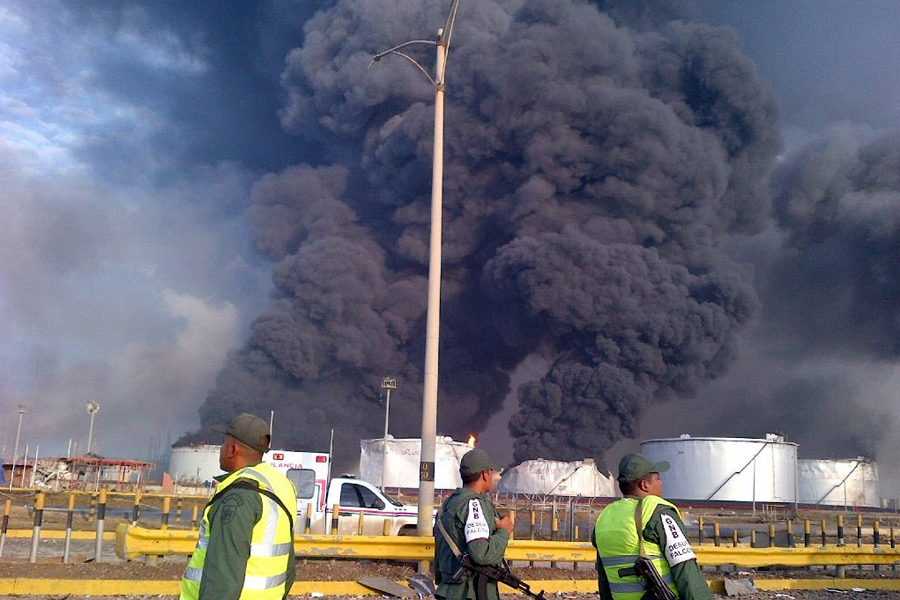What was behind Venezuela's deadly oil refinery explosion?
Loading...
| Caracas, Venezuela
Authorities say foul play was involved in the deadly gas explosion that tore through Venezuela's largest oil refinery last year. The blast claimed at least 40 lives, displaced hundreds of families and caused an estimated $1.7 billion in damages.
"I have the conviction that it was an act of sabotage by factors external to our refinery, our industry," said Petróleos de Venezuela, S.A. (PDVSA) president and petroleum energy minister, Rafael Ramírez, upon releasing a 117-page report of a state-sponsored investigation last week. The report indicates that intentionally-loosened bolts in a gas pump caused a leak that led to the ensuing blast.
Prior to the probe's release, opposition lawmakers decried the tragedy at the Amuay Refinery as "completely avoidable," citing a recent report by Profesionales del Petróleo, an oil industry group.
While the disaster is being dragged further into Venezuela's bitter political strife, industry observers say the Aug. 25, 2012 explosion is more likely a symptom of the overall deterioration at PDVSA. Despite increased investment and a burgeoning staff, the frequency of accidents and reliance on imported refined oil products is stoking fear of mismanagement in this oil rich South American nation.
“Safety is ... part of running a business in this inherently high risk industry " says Jorge Piñon, energy analyst and Latin American specialist at the University of Texas at Austin. "PDVSA has lost sight of that."
Most dangerous
According to company data, the state owned oil company PDVSA registered 519 accidents, causing 3,400 employee injuries and 24 deaths last year. In a recent report comparing PDVSA to its regional state-owned counterparts – Mexico's Pemex, Colombia's Ecopetrol, and Brazil's Petrobras – The Energy Orientation Center, a local think tank made up of oil professionals and former pdvsa employees, found PDVSA the most dangerous. The report used data from PDVSA, Ecopetrol, CITGO, Pemex, and The International Association of Oil and Gas Producers, a global forum, to make comparisons.
Pointing to the continued occurrence of fires, spills, and equipment failures, José Bodas, general secretary of Venezuela’s Federation of Oil Workers Union, says "each accident has it own origin. The overall commonality we're seeing is the lack of maintenance [and] investment, and the incompletion of security regulations."
Despite calls for increased safety and new funding initiatives, "things remain the same," says Mr. Bodas. "We still haven't seen the political will," to change, he says.
Given the rash of accidents at PDVSA facilities, critics remain skeptical of claims of subversion. "We've heard sabotage before," says Eddie Ramírez national coordinator of Gente de Petróleo, a civic association. "One has to ask is sabotage also the cause of falling production?"
Lifeblood of the economy
Oil remains the lifeblood of the Venezuelan economy, accounting for 95 percent of its exports and about 20 percent of its gross domestic product. PDVSA has been striving to boost its output to 6 million barrels a day since 2005, and as of 2007 it had allocated $78 billion to reached the target by 2012.
Staff levels have also swelled. Mr. Ramírez of Gente de Petróleo highlights company data showing staff growth from about 69,000 workers in 2001, to nearly double the staff today, with over 145,000 employees.
But even with the injection of billions of dollars and the addition of thousands of employees, the state energy monopoly’s production has continued to sputter in recent years. According to official OPEC data, the flow of Venezuelan crude has slowed to 2.8 million barrels a day in 2012 from a high of from 3.1 million barrels a day in 1998.
"The only thing they've managed to achieve is verifying that we do indeed have the world's largest proven oil reserves," says Ronald Balza, an economics professor at both the Central University of Venezuela and Andrés Bello Catholic University. As of last year, company data indicates that PDVSA has spent more than $74 billion toward its state goal, and has only certified that the country posses' oil reserves of 297 billion barrels.
"We still lack the technology to get it out of the ground," says Mr. Balza.
The company has since announced an additional $266 billion to reach previous set production goals a by 2019.
"One wonders where the is money going," says Balza.
Besides its energy endeavors, PDVSA also sponsors various government social programs and participates in food production and cultural initiatives. Ramírez stresses the need for social responsibility in the oil industry, but he fears such programs, "distort the primary objective of the company, which is the production of energy."
Critics are quick to highlight that Venezuela is now importing from the US, with whom it maintains strained relations. According to the US Energy Information Administration, Venezuela imported some 3.3 million barrels of oil products from the US, including gasoline in June.
“The clock is ticking for PDVSA," says Piñon.
Editor's note: A previous version of this story mis-cited the author of a report that compares PDVSA to its regional counterparts: It is the Energy Orientation Center, not The International Association of Oil and Gas Producers.





